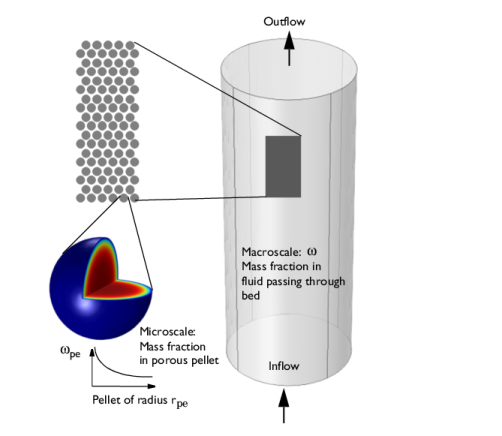
|
•
|
|
•
|
εb is the bed porosity.
|
|
•
|
The dependent variable ωi for each chemical species i represents the interstitial mass fraction, that is, based on unit volume of fluid flowing between the pellets.
|
|
•
|
|
•
|
Ri is the species reaction rate (kg/(m3·s)) in the bed. This corresponds to reactions occurring in the pore space outside of the pellets. Note, that Ri is the reaction rate per unit volume of bed.
|
|
•
|
|
•
|
|
•
|
εpe is the pellet (microscale) porosity.
|
|
•
|
As in Equation 3-22, ωpe,i is the interstitial (physical) species mass fraction of fluid volume element inside the pore channel in the pellet.
|
|
•
|
Jpe,i is the mass flux for species i inside pellet. It is similar to the mass flux in Transport of Concentrated Species.
|
|
•
|
upe is the velocity of mass bulk in the pellet.
|
|
•
|
Rpe,i is the pellet reaction rate for species i. This corresponds to reactions taking place inside the pellets. Note that the user input of Rpe,i is per unit volume of pellet.
|
|
•
|
κpe is the permeability inside pellet.
|
|
•
|
μpe is the dynamic viscosity inside pellet.
|
|
•
|
Mass fraction constraint: assuming that all resistance to mass transfer to/from the pellet is within the pellet and no resistance to pellet-fluid mass transfer is on the bulk fluid side. The mass fraction and pressure in the fluid will thus be equal to that in the pellet pore just at the pellet surface:
|
|
•
|
Film resistance (mass flux): The flux of mass across the pellet-fluid interface into the pellet is possibly rate determined on the bulk fluid side by film resistance. The resistance is expressed in terms of a film mass transfer coefficient, hDi, such that:
|
 .
.